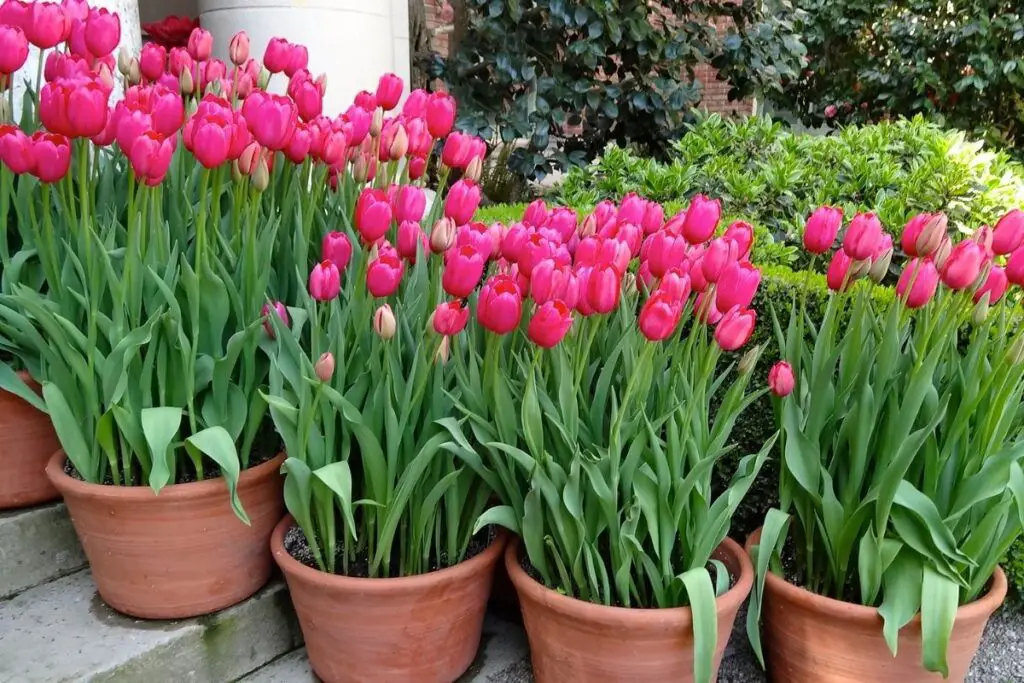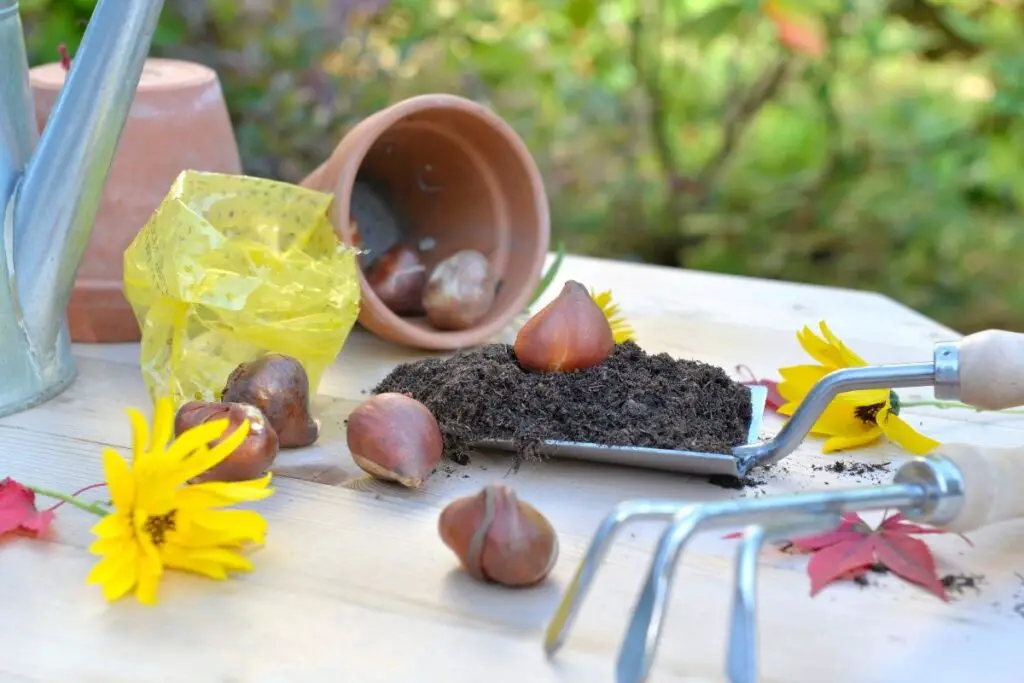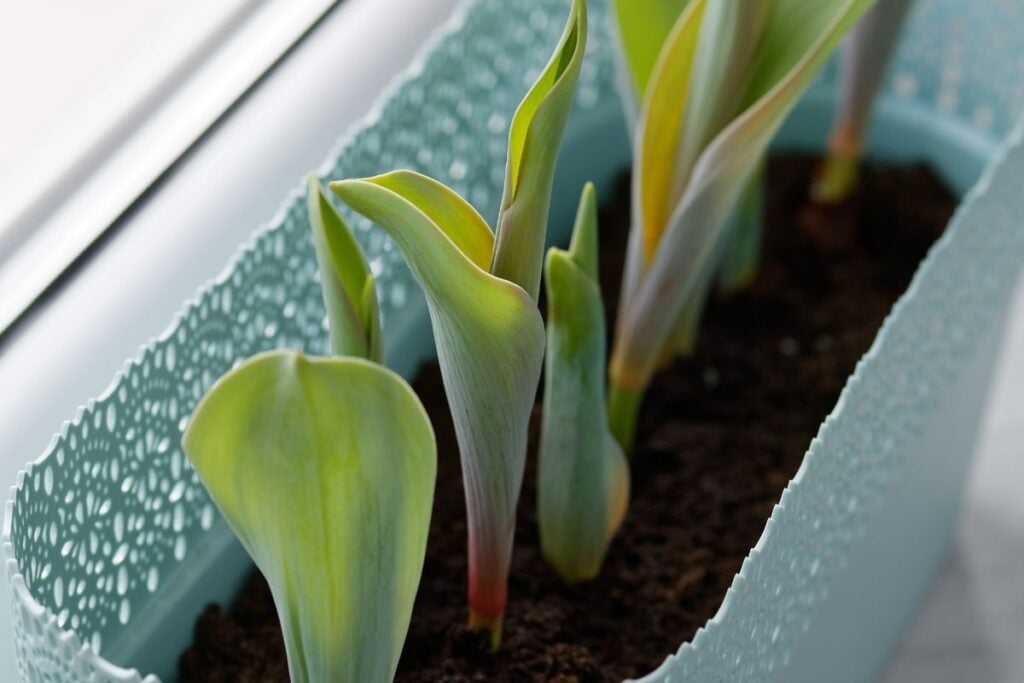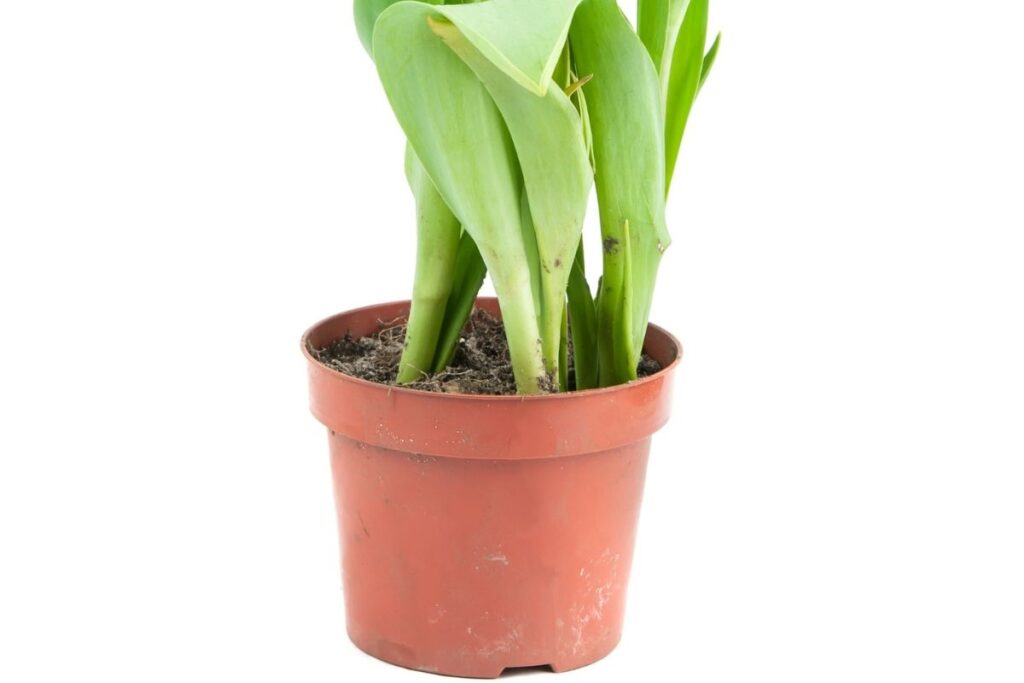Tulips (Tulipa spp.) are known for their bold colors, beautiful shape, and symmetrical pattern. Their vibrant shades cast positivity and cheerfulness among the onlookers; that is why they are valued deeply.
A single tulip is enough to brighten a site. Now imagine a cluster of these magnificent species. Don’t they resemble the beauty of a rainbow?
But should tulips be planted in groups? Let’s find out.
As a general rule, tulips are planted in groups as they look beautiful in a cluster, and it makes caring for them much more manageable. You can plant tulips bulbs with a gapping of 3-5 inches in the yard. While growing them in pots, you can plant the bulbs 2-3 inches apart to give a fuller look.
Here is how to give these vibrant species the best chance of growing successfully in a group.

How to plant tulips in groups?
Garden designers know that tulips look their best when planted in groups. The outcome of planting 10 or more tulip bulbs of the same variety in a cluster has a significant visual impact on the garden.
The voluminous colorful, vibrant site is a visual treat. But wait! It’s better to have your scenic spot for real than to visualize it in a dream.
So how can you do that? We are here to guide you through this task. Let’s start with some basic info, followed by a detailed procedure.
Preparing the soil

As for tulips, dry, loose soil is the best choice as these plants never prefer damp soil and instantly get affected by it. Preparing the soil is crucial to start.
To maintain the porosity of the soil, add pine bark, gravels, or small pebbles, sand, etc., to the soil. Use a digging fork to dig the soil a few inches deep. This step is necessary for the soil to be loosened up and aerated.
Add compost mix with the garden soil or native soil in a 1:2 ratio to keep it nutrient-rich.
As tulips are temperature sensitive, soil temperature measurement is essential. Before planting, do check the soil temperature. It should remain between the 32 and 50°F range. A shift from this temperature range will affect the growth.
Prepare the soil during the fall season. The soil must cool down below 55°F from summer heat to support optimum growth.
Also read: What Kind Of Soil Is Good For Tulips? (Best Soil Mix)
Arranging the bulbs
After cultivating the soil thoroughly and arranging the bulbs in the spot specified for them, you need to put a mix of diluted bulb fertilizer to ensure sufficient nutrient supply to the roots that are about to grow.
You can also add a layer of compost to prepare the bed.
- For a full look, you can place as much as 10 or even more bulbs in a single planting hole.
- Arrange 9-12 unpeeled tulip bulbs on average per square feet area.
- Maintain 2”-3” of space among the bulbs.
- Position the bulbs in the planting holes with the pointed side upward, maintaining the space between them.
- Water the bulbs before covering them with soil as it is essential to stimulate growth. Tulips do not require additional watering during winter.
- Pour soil over the cluster and press the soil mix firmly. You can add mulch to ensure proper draining and to deter weeds. After this, give the bed a final touch.
- Pour some water on the soil to moisten it and give it a firm grip.
Also read: When To Plant Tulips Seeds? (Guide As Per Your Zone)
Looking for gardening supplies? We have tested 100's of products before recommending them to you guys. Check out our best pick below:
| Image | Gardening Supplies | Best Price? |
|---|---|---|
 Top
Top Top
Top | Raised Garden Bed Kit | Check On Amazon |
 | XLUX Soil Moisture Meter, Plant Water Monitor, Soil Hygrometer Sensor for Gardening, Farming, Indoor and Outdoor Plants, No Batteries Required | No Results |
 Top
Top Top
Top | 82 Pcs Garden Tools Set and Extra Succulent Tools Set | Check On Amazon |
 | Joeys Garden Expandable Garden Hose with 8 Function Hose Nozzle, Lightweight Anti-Kink Flexible Garden Hoses, Extra Strength Fabric with Double Latex Core, (50 FT, Black) | No Results |
 Top
Top Top
Top | Dual Chamber Compost Tumbler | Check On Amazon |
 Top
Top Top
Top | Sunnyglade Plant Stakes | Check On Amazon |
 Top
Top Top
Top | Organic Cold Pressed Neem Seed Oil | Check On Amazon |
 Top
Top Top
Top | Mighty Mint Gallon :-Insect and Pest Control Peppermint Oil | Check On Amazon |
 Top
Top Top
Top | Scotts DiseaseEx Lawn Fungicide | Check On Amazon |
 Top
Top Top
Top | Jacks Classic 20-20-20 All Purpose Fertilizer | Check On Amazon |
 Top
Top Top
Top | 30,000 Seeds Pollinator Attracting Wildflower Mixture | Check On Amazon |
 Top
Top Top
Top | Survival Vegetable Seeds Garden Kit-Over 16,000 Seeds | Check On Amazon |
Tips for planting tulips in clusters

Plant tulips in clusters with 5-10 bulbs per group that are chosen based on color.
While soft pastel colors create a more relaxed ambiance, a mixture of bright primary colors exerts a festive look.
From soft, calm shades to bright warm colors, tulips can do wonders to the beauty of both outdoor and indoor spots. Group them accordingly.
Go for perennial variety since they have a longer life span and carry a higher chance to rebloom.
Don’t mix different varieties of tulips in a single cluster. Each variety has its own nutrient need, tolerable temperature range. Grouping various types together will complicate the care routine.
Also read: Do Tulips Grow Back Every Year? (+How To Encourage To Grow Back)
Advantages of planting in clusters
There are some differences between planting a single tulip bulb and planting a cluster. Indeed there is a remarkable impact exerted by the second type of planting. Let us know about the advantages before choosing it.
- Less effort: While digging a single hole for each bulb requires a lot of effort, digging a deeper-bigger hole that can house 10-12 bulbs together seems effortless. Almost with equal effort, you can prepare a better arrangement for beautifying your spot. It not just saves your effort but saves your time too.
- The outcome is way more impactful: Imagine looking at a single tulip popping out and standing alone on the spot (be it in the outdoors or some indoor pot). Now visualize a group of 7-10 vibrant colored tulips swinging together in that same spot. Which one catches your attention more? The answer is obvious.
- Care routines become simpler: Although caring for something on an individual level is consistently more effective, there remains a chance of misconduct due to overcare. When you follow the same care routine for a group of tulips placed together in a single planting hole, the risk of overwatering, overfertilizing becomes less as the content of any component gets divided among all.
- Protection from wind: If you stay in an area that experiences excess wind flow and still have plans to grow tulips, group plantation is the best way to save your plants from wind current. Solitary plants will face many difficulties coping up with strong winds. This point is applicable mainly for outdoor cultivation.
- Exchange of moisture: Grouping your tulips effectively enhances moisture content in the surrounding air. Plants exchange moisture among them through transpiration which is quite helpful during dry seasons like winter.
Special care

If you have decided your preference for a group plantation of tulips, you need to know about the care routine for tulips planted in groups.
Well, the care routine does not differ much from the individual pattern. However, you need to check some factors involved in it. Proceed further with this article to know more.
Care of tulips during storage: Proper storage before planting is essential to promote healthy growth when it comes to tulip bulbs. Keep the bulbs in a paper bag and not in plastic. Store them in the refrigerator at a cooler temperature.
Don’t keep them ripping fruits, especially apples, as they emit some specific gas like ethylene that kills the flower bud inside the bulb.
If you don’t have a place in the refrigerator, just keep the bulb in some dry, calm, and well-ventilated place. For forced blooming, chilling the bulbs for a specified time is essential and can not be skipped.
Light: All varieties of tulip prefer to grow in full sun once they start to grow. Try to plant your tulips at a spot where they get indirect but the full sun.
Water: Water the bulbs immediately after planting. This is necessary to promote growth in tulips. But after this, withhold watering. During dry spells, water the plant once or twice a week.
If your region gets frequent or daily rainfall, do not water the tulips at all. Tulips are native to dry, arid regions of Central Europe and Eastern Asia, so the more accurately you mimic the climatic condition, the longer your tulips will survive.
Temperature and humidity: Tulips are cold-loving species. They thrive in areas that have cool to cold winters and dry summers. They need an average temperature below 55 degrees Fahrenheit for nearly 12-14 weeks to bloom properly. Make sure your tulip bulbs undergo that much cold temperature.
If your location doesn’t have a chilly winter, you need to mimic the cold climate by preserving the bulbs in the refrigerator before planting.
Tulips prefer dry weather, and they have the slightest preference for the damp climate. Make sure to keep the bulbs dry while preserving them.
Fertilizers: Every plant requires a nutrient supply. Tulips are not exceptional in this case, but their need is minimal. You can add bone meal, compost, or granular fertilizers to the planting hole before placing the bulbs. Feed them again in the spring when they sprout. They don’t need too much of it.
Propagation: The most common way to propagate tulips is by taking out the bulb during the planting season, i.e., fall, from the soil and dividing the offset bulbs (or the bulblets) attached to the parental bulb.
Examine the offsets. If they appear soft, discard them. Replant the healthy bulblets at a depth about three times the bulb’s diameter with the pointed side upward.
With these general care and some handful strategies, you can set your spot with vibrant-looking tulips.
Tricking the tulip bulbs: Tulips need a cold climate to bloom perfectly. When you plant them late or during spring, the soil remains warm and doesn’t let them reach dormancy and bloom. If you want to cherish spring bloom, you must start late winter.
There is an essential tip to trick tulip bulbs when they are being planted late.
- Start watering the bulbs regularly.
- Within one week or so, the bulb will start to bloom.
- Keep the flower in indirect sunlight to prolong the bloom time.
- If you want the bulbs to bloom even earlier, you can go for forced blooming in a pot.

FAQ
How long will it take for the new bulbs to bloom?
Well, you need to be patient with it as for the first few years, the new bulbs will produce foliage but not flowers. The tulip bulbs need at least 3 years to be fully mature to support blooms.
Is there any need to soak the tulip bulbs before planting them in groups?
The bulbs planted in the fall need to be soaked in warm water for at least 12 hours before planting as it allows the bulb to absorb water rapidly necessary for their growth and helps to save energy expenditure of about 2-3 weeks. This procedure is beneficial in climates where winter arrives early and slows down the rooting.
Do tulips multiply?
Tulip species don’t rebloom every year. Their bulbs multiply, form clumps, and become bigger with each passing year. This natural phenomenon is called neutralizing.
As bulblets form from the parental bulb, they grow and eventually bloom after getting maturation in the next coming seasons.
How many tulips are in a bulb?
Usually, tulips have one bud per bulb. Few lesser-known varieties sometimes possess more flower bulbs, but that is very rare. But side bulbs known as bulblets may form, and that can produce flowers too.
Can tulips be transplanted after they have sprouted?
Yes, tulip bulbs can be transplanted only after they sprout. Try to apply for a transplant during their dormant period. Be extremely careful with the roots while transplanting the bulbs, as damaged roots will ultimately kill the plant. Dig the soil far enough around the bulbs to protect the roots.
What is a companion plant for a tulip?
Tulips themselves are an eye-catching wonder, and when planted in groups, their beauty increases a few folds more. However, you can plant some other species with tulip clusters for dealing with many purposes.
Planting tulips with day-lilies or other summer-blooming variants help them to hide their drying out of the foliage. Catnip, Candytuft, Bells of Ireland are some of the best companions for tulips.
Tulips genuinely act as a key for upliftment when it comes to beautifying a spot. I hope our article has provided all the info you need and clear your confusion regarding planting tulip clusters.
So now, are you ready to start growing your tulips together? To find a perfect spot that can house these supreme varieties and beautify the surrounding. Have a happy planting day.
Source: Wikipedia, North Dakota Stae University, The Royal Horticultural Society.
